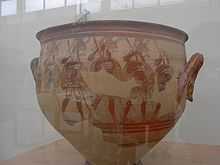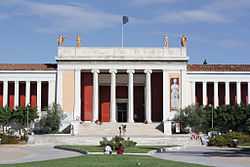Warrior Vase

Detail
The Mycenaean Warrior Vase, found by Heinrich Schliemann on the acropolis of Mycenae, is one of the prominent treasures of the National Archaeological Museum, Athens.[1] The Warrior Vase, dated to the 13th century BCE, is probably the best-known piece of Late Helladic pottery.[2] It is a krater, a mixing bowl used for mixing water and wine, for the ancient Greeks never drank wine unwatered.
The broad frieze of armed soldiers on the vase, which is incomplete, suggested the name that Schliemann gave it. The warriors are clad in short chitons, breastplates, helmets and greaves; they are armed with spears and carry shields. The bull's head handles for long encouraged scholars to date the piece later, in the early seventh century BCE.
Notes
- ↑ The Warrior Vase
- ↑ Early Late Helladic III C.
| ||||||||
